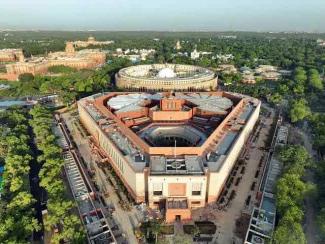
On the twenty-second anniversary of the December 13, 2001 terror strike on India's Parliament, the new parliament building witnessed a stunning smoke scare. A young man, identified as Sagar Sharma from Lucknow, suddenly jumped from the visitor's gallery and opened a yellow smoke canister leaping across tables before being overpowered and handed over to the police by parliamentarians even as the zero hour was underway. Sagar had a companion, D Manoranjan from Mysuru, who too opened another smoke canister spraying yellow smoke remaining seated on the visitor's gallery. A few minutes earlier, two other young persons, Neelam Azad from Hisar, Haryana and Amol Shinde from Latur, Maharashtra, had burst red and yellow smoke canisters outside the building and raised slogans against unemployment and atrocities on women, hailing the motherland and denouncing dictatorship.
Two more persons have been named involved in this smoke canister episode - Lalit Jha, at whose Gurgaon home the group stayed before undertaking the operation, and Vicky Sharma, also from Gurgaon. Manoranjan and Sagar Sharma had secured visitor's passes at the recommendation of Pratap Simha, BJP MP from Mysuru since 2014. Manoranjan is known to be an engineering graduate who used to help his father with their family farming. Neelam has a number of degrees and also cleared the National Eligibility Test for a teaching job but still has not got one. Sagar drives a rented e-rickshaw in Lucknow and Amol, an Army job aspirant, has now crossed the age limit following the introduction of the Agniveer scheme. Lalit Jha used to give tuition in Kolkata before leaving the city in early 2022.
All these young people were reportedly members of a Facebook page dedicated to Bhagat Singh. Indeed, the smoke canister episode seems designed to invoke memories of the historic Central Assembly bombing by Bhagat Singh and Batukeshwar Dutt on 8 April 1929. Just as Bhagat Singh and Batukeshwar Dutt wanted to draw the people's attention to the injustices of British rule, Neelam, Manoranjan and their companions tried to protest against raging unemployment in today's India. Evidently, like Bhagat Singh and Batukeshwar Dutt, they too did not want to hurt or kill anyone, they only wanted to draw attention to the growing plight of the people and shrinking democratic space in the country.
The incident has exposed a major breach in Parliament security. There has been a lot of talk about the tight security system of the new parliament building. Given this, the entry of smoke canisters into the building inevitably raises serious questions. For the Godi media, the smoke canister episode became yet another occasion to indulge in competitive sensationalism, with reporters literally jostling among themselves to grab the canister as a propaganda war trophy.
It is also not difficult to imagine what the media reaction would have been like had the visitor's pass been obtained using a recommendation from some opposition MP or if the group of six included any Muslim name. Surely, the media would have lost no time discovering some major terrorist conspiracy, maybe even some act of 'jihad' attributed to Hamas.
The Modi government surely owes an urgent explanation to the people about the entire episode. An opposition MP has just been expelled allegedly for jeopardising national security by sharing her parliamentary login ID, another MP has been admonished for publicly commenting on the Ethics Committee proceedings. What happens now to a BJP MP for recommending the entry of visitors who caused a smoke scare right inside the Lok Sabha? But far from answering the people, the regime has arrogantly suspended more than a dozen MPs for demanding answers from PM Modi and Home Minister Shah. And now the protesting youth have been booked under UAPA.
The BJP keeps blaming the nomenclature used in colonial historiography that described Bhagat Singh and his comrades as terrorists and not patriots. Today, nearly a century later, with young protesters seeking to emulate the mode of protest employed by our freedom fighters, the government is following the same colonial approach of persecuting the protesting youth as terrorists. Indeed, the regime now seeks to rule by snuffing out every expression of dissent and criminalising every mode of protest and agitation. This is precisely what Bhagat Singh had forewarned us about when he spoke of ‘bhure angrez’. Freedom must not be reduced to the rule of brown Englishmen imitating white Englishmen and subverting constitutional democracy with colonial era repression.
Charu Bhawan, U-90, Shakarpur, Delhi 110092
Phone: +91-11-42785864 | Fax:+91-11-42785864 | +91 9717274961
E-mail: info@cpiml.org




